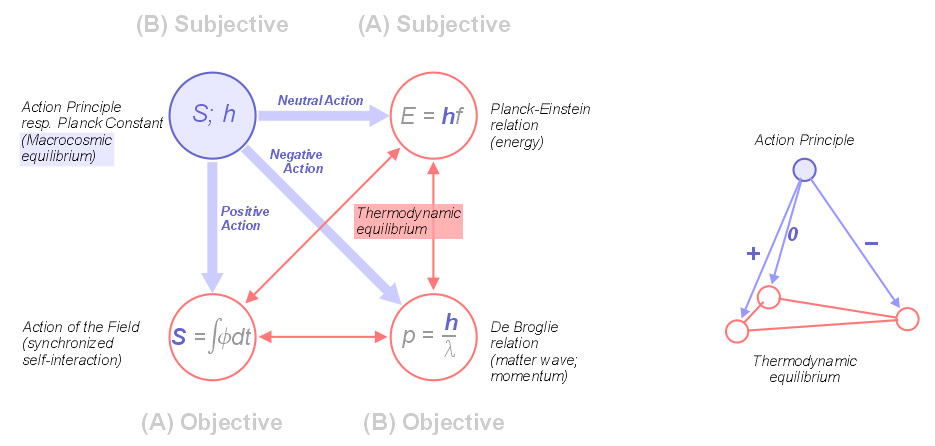Three categories of microvita, three bifurcation relations
| • Can positive, negative and neutral microvita be understood in terms of Quantum Physics? • How are microvita maintaining the "equilibrium in the macrocosm"? • How can we model the Action Principle and its 3 bifurcation relations? |
Microvita and the "4 Chambers of the Universe"
P.R. Sarkar distinguishes 3 categories of microvita: positive, negative and neutral, e.g.:
"But not all microvita are the enemies of human beings - some are inimical, some are friendly and some are neutral." [Some Examples of Microvita in Daily Life - Section A]
"There are positive or friend microvita, negative or enemy microvita, and neutral microvita." [Questions and Answers on Microvita – Section A]
(In the side line, this is really a thing: the literal term "positive microvita" appears 152 times, "negative microvita" 181 times and "neutral microvita", well, 2 times).
Generally speaking, "positive" here means "pro-life" and "pro-mind", and negative "pro-matter". Obviously these are relative characterizations, not per sé "good vs. bad" qualifications.
How to understand these categories in terms of a Quantum theory of microvita? Firstly, we have to consider that "microvitum" is to be thought of as another term for the smallest quantum of Action ("S") , which in physics is the Planck constant ("h") , but now in the greatly extended context of microvita theory, that is, the "(quantum) physics of life".
As Sarkar indicated, the "Action Principle" (B - subjective) bifurcates into relatively external factors, initially "Energy" (A - subjective). This is analogous to the concept of symmetry breaking in physics, but with a much broader implication. The other factors are "Inferences" (B - objective) and "Propensities" (A - objective).
Especially "Propensities" is new with respect to physics. It literally means "tendencies", and in the current context especially mental tendencies. It means that matter is no longer only being controlled by the blind force of Energy (thermodynamics) but also by a positive, evolutionary, interior factor, which practically implies mind. In other words, "Propensities" means that matter has become alife, and moves into a new direction..!
Obviously, the latter, "pro-mind, pro-life" quality is the most distinctive aspect of microvita, and surely implies positive microvita. Microvita related to "Inferences" is the matter-oriented, relatively "negative" aspect, and microvita related to "Energy" is the neutral expression.
The 3 bifurcation relations in Quantum Physics
Firstly, the Action-Energy relation is very well known in physics, and this is how the Action Principle is used all the time for solving complicated problems. This has unfortunately not earned it the status of a fundamental principle in nature, such as emphasized by Sarkar and also by others. Nevertheless, an idea analogous of "neutral microvita", in a technical sense, appears very familiar in physics.
Secondly, an Action-Inference relation may at first appear not very common in physics, but could (likely) be interpreted as the Action-Momentum relation. The latter became famous as the De Broglie relation p = h / lambda, i.e. relating the momentum (of a particle / matter-wave) to the Planck constant and the wave-length. These waves could, under circumstances, be thought of as Sarkar's "Inferences". In other words, the concept of "negative microvita" is also used in physics.
Lastly, the Action-Propensities relation is entirely unknown in physics. What is known in a general sense is the concept of synergy or neg-entropy, as the principle that counteracts thermodynamics. A well-spun idea of synergy is currently non-existent in quantum physics, and certainly not in relation to the Action Principle. So, this would be a great innovation indeed. In the current context, it would mean the application of positive microvita in physics, helping to create, in Sarkar's words, "carbonic auxiliaries", that is, living organisms.
Whereas the Planck constant, in singular form, is very explicit in the energy- and momentum relations, it appears somewhat obscured in the case of "Propensities". In this case, the quantization is not a plain quantitative breakdown of the Field's dynamics, but quite literally an integrative, synergetic, and in a sense qualitative application of the Principle of Least Action, based on synchronized bifurcation, making the common so called "quartic self-interaction" obsolete.
Creating equilibrium
Now, having an inventory of the Action Principle plus its 3 different interactions - positive, neutral, negative - given the general concept of "bifurcation", we can see that there must be 3 different types, or aspects of bifurcation, obviously positive, neutral and negative. This turns out to give a relatively prominent position to the Action Principle, as the central organizing principle of the 3 other factors, "maintaining the macrocosmic equilibrium". This is shown in Sarkar's "4 Chamber" diagram, and can also be modeled as a Tetrahedron:

| The 3 aspects of bifurcation, or 3 microvitic actions. In this model, "h" (resp. "S") each time shows the involvement of the Planck constant, and thus, in principle, of a microvitum, through the resp. bifurcations, in the total external expression. At the left, the quantum relations in Sarkar's "4 Chamber" diagram. The integral in (A) objective is shorthand for the unitary, bifurcative self-interaction. At the right, the same modeled in 3D as a tetrahedron. |
Summary
Sarkar identified 3 categories of microvita, or microvitic actions, that is: positive, negative and neutral. These are thought to relate to and control 3 of the 4 Chambers, resp. "Propensities", "Inferences" and "Energy". Of these 3, "Energy" (and its interaction) is very well known in physics. Also "Inferences" is known, through the De Broglie relation or matter-wave. The "Propensities" chamber may be known in a general sense as "synergy" or "neg-entropy", but not in explicit relation to the Action Principle. Obviously it is especially the latter relation (micro-vita...) which Sarkar aimed to introduce and elaborate upon in great detail, while at the same time rehabilitating the Action Principle to its highly deserving status of a fundamental principle in nature.